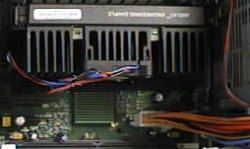|
AMD Athlon 600, Millenium G400 MAX
by Tim "Flyboy" Henderson |
||||
|
System Configuration
 The AMD Athlon. The big kahuna. An enigma wrapped in a puzzle shrouded in a mystery .. the... ok, ok already. How about, the Giant killer? The AMD Athlon Much has been written and philosophized about Intel vs. AMD, David vs. Goliath etc etc ad infinitum. I don't really want to tread that tired route. But I admit to being a tad delirious when I first installed this CPU and fired up the machine. My previous system was a PII 450 (non Celeron) and I decided to make the leap of faith and build my first fully AMD system. With a little help from our friendly local editor, the system became a reality! Thankfully, I was already guilty of exceeding the family budget with recent upgrades, so importing my Quantum hard drive, Millenium G400 MAX, Toshiba CD ROM, and the ancient SDRAM memory from my previous system made this conversion simple. I expected to gain at least 30% in CPU power, and I wasn't disappointed. Not that long ago the K6 evolved into the K7, a new CPU that would rival Intel's Pentium III. This would be the CPU that would finally not only match the horsepower of the floating point unit on Intel's flagship CPU, but even surpass it. With the introduction of the Pentium III Intel added SIMD, Single Instruction, Multiple Data. Streaming SIMD is seventy 3D accelerated multimedia instructions built onto the CPU similar to 3DNOW!, which was introduced by AMD back in 1998 in their K6 series. |
Like 3DNOW!, the new instructions in the Pentium III allow the CPU to handle some 3D calculations directly, thus creating more FPS for the games that support SIMD. While Intel was beefing up their CPU, AMD was doing similar work. Nineteen new instructions were added, allowing the K7 to process more data in a given amount of time. Those instructions will enhance the K7's integer and cache performance. The Athlon also adds five new DSP extensions, allowing the K7 to more efficiently decode multimedia files like MP3 audio files, or do software processing of communications algorithms like ADSL. While both processors share a 512KB half speed cache, the Athlon quadruples the size of the Pentium III's 32KB L1 cache to 128KB. As with Intel's new instructions, for a game to support 3DNOW! it must be coded in the software. While the API can do some of the work (DX7 has some support), maximum advantage can only come from the game designer.
 But the real hidden power of the K7 does indeed appear to be its FPU. The Pentium III has 2 floating point execution units, only one of which is fully pipelined. The Athlon expands this to 3 fully pipelined execution units. If you recall, way back this spring (May?) Dirk Meyer, vice-president of engineering for AMD, offered the first performance estimates for the final K7 silicon. Meyer compared 550-MHz and 600-MHz versions of its K7 with Intel's 550-MHz Pentium III Xeon. Both chips were optimized for their respective instruction sets: Streaming SIMD Extensions (SSE) for Intel's chips, and the enhanced 3DNow! instruction set for AMD. In floating point calculations, used extensively in multimedia applications, the 550-MHz and 600-MHz K7 outperformed the Xeon by 35% and 40%, respectively, using the SPECfp measurement. Go to Part II: Benchmarks
|
|||
|
Copyright © 1997 - 2000 COMBATSIM.COM, INC. All Rights Reserved. Last Updated September 30th, 1999 |
||||
